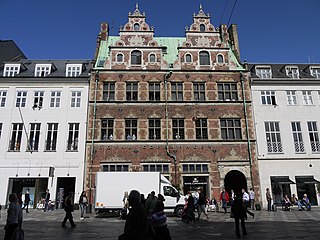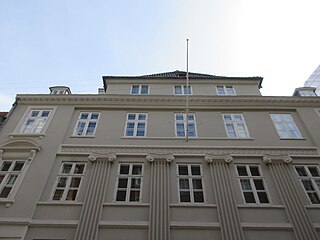
The Matthias Hansen House, formerly also known as the Schoustrup House, is a Renaissance-style townhouse on Amagertorv in central Copenhagen, Denmark. Built in 1616, it is one of few buildings of its kind which has survived the Copenhagen Fires of 1728 and 1795. The building is now home to a flagship store for the Royal Copenhagen porcelain factory.

The Waagepetersen House is a listed Neoclassical town mansion located at Store Strandstræde 18 in Copenhagen, Denmark. The house takes its name after royal wine merchant Christian Waagepetersen who owned it from 1811 to 1840. His home was a meetingplace for many of the leading figures of the Danish Golden Age.

Christian Waagepetersen was a Danish wine merchant and patron of the arts. The Waagepetersen House, his home on Store Strandstræde in Copenhagen, was a meeting place during the 1820s and 1830s for many leading figures of the Danish Golden Age. The neoclassical building is now listed.

Amaliegade 14 is a Rococo-style building in the Frederiksstaden neighbourhood of central Copenhagen, Denmark. It was listed on the Danish registry of protected buildings and places in 1918.

Nyhavn 49 is a listed apartment building situated at the corner overlooking the Nyhavn Canal in central Copenhagen, Denmark. It originates in a two-storey townhouse from 1746 which belonged to the businessman and bank manager Rasmus Kirketerp from at least the 1790s and remained in the hands of the family until at least the early 1850s. This building was later heightened twice, first in the 1850s and then in 1887. The present building contains an ice cream parlour with homemade waffles in the basement and two residential apartments on each of the upper floors. It was listed in the Danish registry of protected buildings and places in 1945. Other notable former residents include the painter Otto Bache.

Nyhavn 35 is a historic townhouse overlooking the Nyhavn Canal in central Copenhagen, Denmark. The building was listed in the Danish registry of protected buildings and places in 1945. Notable former residents include the businessman Jørgen Thomsen Bech and the composer Andreas Peter Berggreen.

Kjøbenhavns Brandforsikring, founded in 1731, was the first Danish provider of fire insurance in Denmark. It existed as an independent enterprise until 1976 and is now part of Tryg. The company's last headquarters was the Gustmeyer House at Ved Stranden 14 in central Copenhagen.

Amaliegade 43 is a Neoclassical property in the Frederiksstaden district of central Copenhagen, Denmark.

Ved Stranden 16 is a narrow, mid18th-century property]] located opposite Christiansborg Palace in central Copenhagen, Denmark. The building was listed on the Danish registry of protected buildings and places in 1918. It is flanked by the former Hotel Royal to the left and the Gustmeyer House to the right.

Store Kannikestræde 8 is a historic building in the Old Town of Copenhagen, Denmark. It was listed on the Danish registry of protected buildings and places in 1945. It has been in use as the parish house of Trinitatis Parish since 1890. Notable former residents include the historian Rasmus Nyerupm illustrator Peter Christian Klæstrup and the architect and urban planner Conrad Seidelin.

August Willads Bech was a Danish landowner. He owned Valbygård at Slagelse and Borupgård at Borup. Valbygård is still owned by his descendants.

Ludvig Lorentz Mozart Waagepetersen was a Danish wine merchant. He is now mainly remembered for founding the Rosenvænget quarter of Østerbro in Copenhagen.

Reventlowsgade is a street in the Vesterbro district of Copenhagen, Denmark, which follows the "Vesterbro side" of Copenhagen Central Station, between Vesterbrogade to the northwest and Tietgensgade to the southeast. One of the entrances to the Copenhagen Central Station City Circle Line metro station is located in the street. The street was refurbished in conjunction with the opening of the metro station, with new trees, seating and facilities for bicycle parking.

Albrecht Ludwig Schmidt was a Danish merchant and ship-owner. A co-founder of Schmidt & Andresen, he made a fortune on trade in the Far East and Danish West Indies. Two monumental portrait paintings painted from 1818 by C. W. Eckersberg of Schmidt and his wife are now owned by the Hirschsprung Collection.

Nybrogade 24 is an early 19th-century property overlooking the Slotsholmen Canal in central Copenhagen, Denmark. It comprises a four-storey, seven-bays-wide residential building towards the canal and a warehouse at Magstræde 11 on the other side of the block as well as a small courtyard between the two buildings. The entire complex was built in 1815-17 for the wealthy merchant and ship-owner Jørgen Peter Bech, grandfather of the writer Wilhelm Bergsøe who provides an affectionate account of his many visits as a child in his 1898 memoirs De forbistrede drenge. The entire complex was listed in the Danish registry of protected buildings and places in 1918.

Skindergade 21 is a Neoclassical property situated on Skindergade, opposite Lille Kannikestræde, in the Old Town of Copenhagen, Denmark. It was listed in the Danish registry of protected buildings and places in 1964. Former residents include architect Michael Gottlieb Bindesbøll, poet Henrik Hertz, painter Heinrich Hansen and politician Carl Theodor Zahle.

Rådhusstræde 1/Brolæggerstræde 13 is a Neoclassical property overlooking Nytorv-Gammeltorv from its location at the corner of Rådhusstræde and Brolæggerstræde in the southeastern corner of the square, in the Old Town of Copenhagen, Denmark. The building was constructed by Andreas Hallander as part of the rebuilding of the city following the Copenhagen Fire of 1795 but owes its current appearance to a comprehensive renovation undertaken in 1851 for lawyer Carl Liebenberg. It was listed in the Danish registry of protected buildings and places in 1918. Former residents include the politician Christian Colbjørnsen, physician and former director of the Danish West India Company Johan Friedrich Heinrich and composer W.H.R.R. Giedde. Posthusteatret, a combined theatre and art cinema, is based in the basement.
Brorupgaard is a manor house and estate situated close to Slagelse in Denmark. It was owned by Ludvig Holberg from 1740 until 1754. The current main building was constructed by August Willads Bech in 1856 and the estate has remained in the hands of the Bech family since then.

Admiralgade 25/Laksegade 32 is a Neoclassical property situated at the corner of Admiralgade and Laksegade in central Copenhagen, Denmark. It was constructed for goldsmith Christian Nielsen Lindbach after his previous building on the site had been destroyed in the Copenhagen Fire of 1795. It was listed in the Danish registry of protected buildings and places in 1939.

Jørgen Thomsen Bech was a Danish businessman.



















